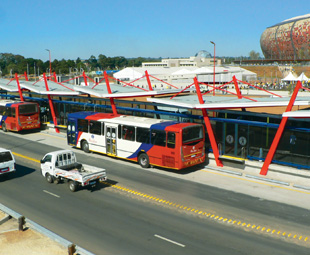Transport and human rights in Africa

Can bus rapid transit systems work in Africa? The question was hotly debated at the second African Association of Public Transport congress and exhibition held in Johannesburg recently. BLAIR BURMEISTER went along to find out if BRT systems are going to be a sustainable option for African cities.
The African Association of Public Transport (UATP, Union Africaine des Transports Publics) is an independent association that represents professionals in the field of public transport and the transportation of goods by road, rail, sea, air and water.
This year’s congress focused on bus rapid transit (BRT) systems as an adapted and sustainable solution for mobility in African cities. Keynote speakers from across the continent and beyond shared their experiences, ideas and visions for BRT over an intense four-days.
South African Minister of Transport Ben Martins kick-started the event with an opening ceremony address in which he asked why modern public transport has difficulty taking off in Africa and whether BRT is indeed the answer.
Martins explained how a safe and reliable public transport infrastructure is needed to boost productivity and promote the competitiveness of countries. “High costs and tariffs associated with poor transport infrastructure are some of the reasons why developing countries continue to lag behind the developed world,” he said. “There is no doubt that an effective transport system is a pillar of growth and development in Africa.”
Addressing the challenges facing South Africa in particular, Martins said the lack of adequate public transport infrastructure in both metropolitan and rural areas is exacerbated by the absence of an integrated public transport system to create synergy between various modes of public transport. Looking at the South African experience, he said the introduction of BRT systems in Johannesburg and Cape Town has proven to be a significant intervention, reducing the time it takes people to travel from one area to another.
He said the South African model has been made possible by the involvement of taxi operators as shareholders in the BRT system. He stressed that a lot more work needs to be done to fully integrate bus and taxi operators, saying that this will include further capacity building in the taxi industry.
Addressing the challenges calls for collaboration between all role players within and between countries. “At a country level, this means partnerships between the different spheres of government, bus and taxi operators, and the general public. At a regional and continental level, there is a lot that countries can learn from each other. We therefore need to strengthen regional and continental coordination through multilateral and multi-stakeholder platforms.”
Martins felt the choice of conference theme confirmed the fact that Africa is beginning to look for suitable solutions to address the practical challenges of providing safe and reliable public transport.
Transport researcher for the World Wide Fund South Africa, Gail Jennings, gave an insightful presentation on BRT and one of its prominent challenges: social equity. “Mobility and access to public transport are central to citizens’ rights to access economic opportunities, healthcare, education, food and clean water.”
Jennings said there are still many transport equity challenges to overcome in South Africa and within the rest of the continent as a whole. Her concerns about BRT systems, particularly those in South Africa, focused on the cost of transport, poor reliability and lack of access.
She added that BRT services are only able to serve a minority of the needs for urban populations, saying: “It is unlikely that they [BRT systems] will significantly reduce the transport disadvantages currently experienced by low income populations.”
Jennings said shocking public transport infrastructure and services in Africa have to be turned into a question of human rights infringement. “Mobility is key to every aspect of our lives.”
Heated discussions
At a round table discussion where various BRT system ideas and experiences were shared, chairperson and president of UATP South Africa, Jack van der Merwe, noted that every country differs and that BRT may not be able to solve every city’s public transport issues.
He challenged delegates to consider what the best transport mode for the job is, and whether BRT is able to benefit a country in terms of economic growth. His final question – “Is BRT the answer for public transport in Africa?” – spurred a heated debate and panel discussion.
Patrick Vautier, director of marketing and innovation for the Paris Transport Authority was first to respond, bringing his knowledge of European BRT systems and exploring the associated threats and opportunities.
Vautier highlighted a major success of BRT: people don’t have to ask when the bus is going to arrive. He referred to Istanbul, saying that if a commuter misses a bus there is always without a doubt, another one on its way.
“The system is an advantage,” he said. “There is quick return on investment, and it is inexpensive to maintain. It can additionally bring an advantageous effect on quantity, reducing congestion. This can only be seen, however, when the system has been implemented properly. Each city is different, especially in Africa. No country is the same on the continent, and that must be taken into serious consideration.”
Vautier spoke passionately about the many opportunities for BRT. “Where there is over-population, congestion and the traffic is terrible, there will always be this option. There will be two billion cars in 2050, therefore there is a lot of work to do in terms of perfecting the system – but it provides fruitful opportunities for the economy and, most importantly, for people.”
Dr John Sampson, MD of Transportation and Traffic Technology Africa, was next up, and responded to Vautier’s insights into the European BRT experience, expressing strong views on the African BRT familiarity. “We as Africans need to look at the bigger problems. BRT is part of the solution but it needs to be balanced with other issues in public transport. This is a big problem for African countries.”
Sampson revealed that of the public transportation trips made in Gauteng everyday, 70 percent are in minibus taxis with approximately three percent of those trips made in buses. “The minibus taxi system has taken over from formalised bus and rail systems,” he said.
“A holistic, integrated public transport system is what is needed. People want convenience and speed, and minibus taxis respond to this market,” he said. “It is difficult to do this on a scheduled service and BRT routes can’t just be changed. Most of the transport budget is being spent on BRT, and this will not solve everyone’s transport problems, especially in South Africa.”
Sampson said BRT is a solution, but has to be adapted to the needs of our cities. “BRT is a technological solution. The stakes at an economic level are very important and so are the stakes at a social level. But it needs to be enough to take people out of their cars and promote public transport over private.”
Far too many cities in Africa suffer from severe traffic congestion, and even though many challenges exist, BRT systems do present a practical solution, despite many challenges in adopting them. One factor that was the subject of much deliberation is the need for further efforts to fully integrate bus and taxi operators.
Published by
Focus on Transport
focusmagsa




